|
 Wild Decades and Velvet Hangovers
Wild Decades and Velvet Hangovers
The 2001 Plzeň festival of Czech film
Peter Hames
One of the considerable virtues of the Finále festival of Czech films at Plzeň is the opportunity to see films in a wider context. There are not only the new features and documentaries from the past year but also a Slovak section and a variety of retrospective screenings.
This year, for the 14th festival, there were no less than 17 sections—as well as concerts and exhibitions that included, for instance, pen-aniline (pen and coloured ink) drawings by Slovak director Juraj Jakubisko (selected from 40 years work) and a retrospective tribute to Jiří Suchý and the Semafor Theatre.
This year's featured themes included a second year of tributes to the 1960s under the heading of "the wildest decade of Czech cinematography," devoted to the year 1961, with films by Václav Krška, Václav Gajer, František Vláčil, and Karel Kachyňa.
After the party
The sixties, of course, always provides a point of reference, and with new films by Jan Němec, Věra Chytilová, Karel Vachek, Drahomira Vihanová and Jan Švankmajer, its traditions were very much in evidence. Robert Buchar's two-hour-plus documentary Sametová kocovina (Velvet Hangover, 2000), devoted to interviews with the sixties generation, attracted a good deal of attention and seems the logical place to start this review.
Buchar, who emigrated to the USA in 1980, has produced an intriguing historical document which charts the state of Czech cinema in the sixties, under the years of Normalisation in the seventies and eighties, and its encounter with the new economic "liberalism" of the nineties. While it doesn't have aspirations to be anything other than a "talking heads" documentary, he provides his participants with the opportunity to present a portrait of an era.
Probably the most perceptive comments come from directors such as Jiří Krejčík, Antonín Máša and the former cinematographer Stanislav Milota. There are also contributions from Jiří Menzel, Ivan Passer, Vihanová, Němec, Chytilová and Vachek. The post-89 generation is represented by Saša Gedeon, Jan Svěrák, Jaroslav Brabec and Zuzana Zemanová.
Many directors who had some chance of realising their projects under the nationalised system now have none, and it is natural that they should be disillusioned with the privatisation of the Barrandov studios ("the selling of the family silver"). But the key change resides in the objectives of Czech cinema.
In the sixties, the cinema was seen as something more than entertainment: "We learned to tell the truth—that is no longer fashionable" (Milota); "the objective was 'what to say'" (Máša); "films should come from the inner-self and the problems of the time" (Chytilová); "a good film must be a revolution in expression" (Vachek); "in the sixties, film was a source of ideas" (Gedeon), "I'm used to the idea that film should be the cultural responsibility of government" (Vihanová).
In contrast, notes Saša Gedeon, the present-day objective of cinema is to provide entertainment and is determined by market values. Zemanová suggests perceptively that this may be a world problem: the sixties—"the time of reflection"—are over and "maybe we are not experiencing very much." Maybe, says Máša, the contemporary generation takes things as they are. Milota, in the context of the world's political and social conflicts, the problems of North vs South, notes that the media can exhibit only boredom and indifference.
A bad year for a good national cinema
But what of the films in competition? Many of us were impressed by the range and diversity of the Czech films shown at last year's festival and while, if you subtract Švankmajer's Otesánek (2000), this year's selection is less interesting, as one colleague put it, the creative range is still wider than that of many post-Communist cinemas (or indeed Western cinemas).
Any competition line up that includes Švankmajer's rigorously surrealist film, Vachek's four-hour-plus philosophical essay Bohemia docta (2000) or the inventive and humorous feature documentary Bitva o život (Battle for Life, 2000), co-directed by Miroslav Janek, Vít Janeček and Roman Vávra, suggests—against the odds—that market values do not have it all their own way.
The visual elegance of Petr Václav's Paralelní světy (Parallel Worlds, 2001), which shared the main prize with Otesánek, and the originality of Aurel Klimt's animation in his contribution to Šest statečných (The Magnificent Six, 2000) shows the art of cinema to be still very much alive. In fact, of the 20 films in competition, nearly half were made with no explicit commitment to market values and, of the remainder, many were attempting to achieve something else as well.
Three of what might be viewed as intelligent audience-directed films have already been reviewed in depth in CER (Kytice / Wild Flowers aka A Bouquet, 2000; Cesta z města / Out of the City, 2000; and Anděl exit / Angel Exit, 2000).
F A Brabec's adaptation of Erben's folk/fairy tale collection, A Bouquet, emphasises the perfection of the visual and, in this sense, represents the polar opposite of Švankmajer's approach in Otesánek. While domestic audiences may view it as a sometimes over-elaborate visualisation of a familiar subject, the film could certainly interest foreign audiences, where the cruelty and horror of the original has the power to surprise and shock.
Tomáš Vorel's Cesta z města, with its story of a computer programmer and his return to an idyllic but frequently cruel countryside, is a work of some ambition and complexity, with an impressive performance by Tomáš Hanák in the central role. However, its theatrical interactions sometimes restrict its appeal.
Anděl exit is the one film to present an absolutely caustic and negative view of the post-Communist world but, if one ignores its status as a film of Jáchym Topol's novel, it registers very much as a triumph of style over substance. film of Jáchym Topol's novel, it registers very much as a triumph of style over substance.
The characters lack any redeeming qualities and the plot seems almost trivial. That said, the hallucinatory stream of images is extraordinary and deserves its own analysis—but, several days later, one can recall little more than the fact of its visual-aural assault.
The ever-popular theme of love
Mainstream titles such as Filip Renč's Rebelové (Rebels, 2001) and Marcel Bystroň's Cabriolet (winner of the prize for best debut) certainly entertained their audience and would 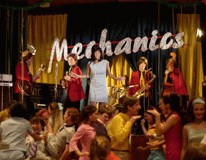 no doubt satisfy the popular culture agenda of media academics. Both are stories of young love and depend substantially on their use of music. no doubt satisfy the popular culture agenda of media academics. Both are stories of young love and depend substantially on their use of music.
Rebelové, which is set in the year of the Prague Spring and the Soviet invasion, features a planned escape to the West and the arrest of one of its central characters for desertion from the army. It's an invigoratingly choreographed retro-musical recalling the clean-living Cliff Richard films of the 60s, but its sense of nostalgia somehow sits unevenly with its context.
Cabriolet (2001), to which Ivan Král's music provides a continuing accompaniment, tells the touching story of a drummer in love with a young woman suffering from an incurable disease.
Petr Václav's Paralelní světy justifiably shared the main award. It's an examination of a marital crisis in which Kryštof (Karel Roden), a successful architect alienated by the need to work for clients with no taste for good design, fails to meet the needs of his emotionally insecure and demanding 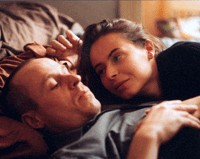 wife, Tereza (Lenka Vlasáková). The crisis leads him to embark on an affair. wife, Tereza (Lenka Vlasáková). The crisis leads him to embark on an affair.
The situation and class of the characters recalls similar themes in Michelangelo Antonioni's L'Avventura (1960) and La Notte, (The Night, 1961) but the characterisation is very subtle and the unspoken fears and links between individuals are beautifully conveyed by Roden and Vlasáková.
Cinematographer Štěpán Kučera, who worked on Václav's earlier film Marian (1996) and Saša Gedeon's Návrat idiota (Return of the Idiot, 1999), finds the perfect visual form for the story's bleak but sophisticated environment. But it is above all the film's balance and its restrained pace—the integration of story, acting, image and rhythm that gradually asserts a hypnotic power. Kryštof and Tereza need each other but their parallel worlds create quite different problems. It's scarcely a new theme or a new situation but it is treated with a rare perception.
Švankmajer's Otesánek, described briefly in my report from Bratislava, is a retelling of the famous folk tale, which is here used as an explicit parallel: a childless couple find a tree root in the shape of a baby and attempt to raise it. In the process, it becomes real, develops an enormous appetite, resorts to cannibalism, and has to be locked in a chest in the cellar.
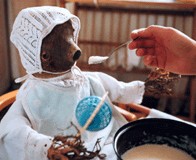 An obnoxious little girl, in between rejecting the overtures of a lascivious old man, notices parallels with the story of Otesánek and takes pity on the creature. The interpenetration of animation with the "real" world will not disappoint Švankmajer enthusiasts and, in its greater concern with narrative, the film will probably reach wider audiences. An obnoxious little girl, in between rejecting the overtures of a lascivious old man, notices parallels with the story of Otesánek and takes pity on the creature. The interpenetration of animation with the "real" world will not disappoint Švankmajer enthusiasts and, in its greater concern with narrative, the film will probably reach wider audiences.
Martin Šulík's Krajinka (Landscape, 2000) won the International Film Societies award and Vihanová's Zpráva o putování studentů Petra a Jakuba (The Pilgrimage of Students Peter and Jacob, 2000) won the award of the student jury.
The recording eye
In a cinema with a strong tradition in expanding the range of documentary expression, Bitva o život, which won a special award, broke new ground with its three-director approach. It records a year in the life of the village of Bystré, 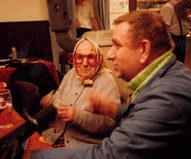 in the Orlické mountains, a former textile region experiencing significant economic and demographic change. in the Orlické mountains, a former textile region experiencing significant economic and demographic change.
The film combines "conventional" documentary footage with discussions on drink and democracy, and a record of social events and festivities in which the villagers greet the millennium, view the eclipse, re-enact scenes from Czech history, carry out war games and engage in the "vaginal" ball. For this viewer, at least, it echoed the mood of Miloš Forman's Hoří, má panenko! (The Firemen's Ball, 1967) but, this time, the characters were for real.
In Bohemia docta aneb Labyrint světa a lusthauz srdce (Božská komedie) (Bohemia Docta or the Labyrinth of the Soul and the Paradise of the Heart [A Divine Comedy], 2000), Karel Vachek's third film in a series he has called "Malý kapitalista" (The Little Capitalist), he continues to explore the interactions between history, philosophy, and politics.
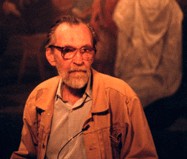 His characteristic overlapping of interviews, themes and dialogue soon moves from the title's juxtaposition of Comenius and Dante to Marx, Alfons Mucha's Slav Epic and the Plastic People of the Universe. His multilevel discussion, interspersed with a taxonomy of mushrooms and castles, ranges from discussions of Roma culture and racism to the writer and artist Josef Váchal, the composer Lukeš, the reopening of the Slavia restaurant, the complex workings of the former security police and comparisons between Dubček and Oldřich Nový, to the poster of Václav Klaus in place of the Stalin monument. His characteristic overlapping of interviews, themes and dialogue soon moves from the title's juxtaposition of Comenius and Dante to Marx, Alfons Mucha's Slav Epic and the Plastic People of the Universe. His multilevel discussion, interspersed with a taxonomy of mushrooms and castles, ranges from discussions of Roma culture and racism to the writer and artist Josef Váchal, the composer Lukeš, the reopening of the Slavia restaurant, the complex workings of the former security police and comparisons between Dubček and Oldřich Nový, to the poster of Václav Klaus in place of the Stalin monument.
Vachek is a true original and his on-screen debates, if you choose to engage with them, can be genuinely instructive. Arguably necessary in a media world where discussion is usually simplified and sanitised, Vachek's film, at over four hours, is best approached in its three-part television format.
Because of the usual festival clashes, I missed Vihanová's film and saw only part of Chytilová's Vyhnáni z ráje (Ban from Paradise, 2001), which is set on a nudist beach. After her excellent documentary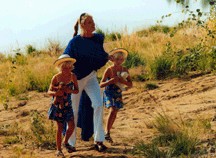 Vzlety a pády (Flights and Falls, 2000), which was screened last year, it seemed at best a disappointment—although it is unfair to comment without seeing the complete film. Vzlety a pády (Flights and Falls, 2000), which was screened last year, it seemed at best a disappointment—although it is unfair to comment without seeing the complete film.
Jan Němec's Noční hovory s matkou (Night Talks with Mother, 2000), filmed on digital video, in which he addresses his mother and discusses his life, was beautifully shot and paced. Prefaced with a reference to Camus' The Outsider, it looks back at key figures in his life (Ester Krumbachová, Marta Kubišová, Václav Havel), at the Soviet invasion (with extracts from his Oratorium pro Prahu / Oratorio for Prague, 1968), his American exile and the Velvet Revolution.
Evocative and dreamlike, and filmed with a specially adapted camera, it gives evidence of what the cinema has lost by his years of silence and exile.
Not the best of both worlds
But what of Sametová kocovina? Are the dire predictions of the older directors justified?
In one sense, it could be argued that Paralelní světy, Cesta z města, and Anděl exit all demonstrate that Czechs are not living in the best of all possible worlds. Many of the 1960s films adopted a similarly oblique approach. But all the feature films seem to avoid direct social and political criticism. There seems to be no Czech equivalent to Ken Loach, Mike Leigh, Stephen Frears or Pawel Pawlikowski.
In this connection, the screening of Evald Schorm's 1964 film Každý den 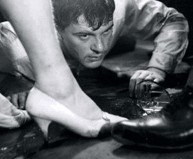 odvahu (Everyday Courage), scripted by Máša, makes an interesting parallel. This story of a disillusioned foreman in a factory linked politics, society, the professional and the personal in a way that none of the new films have attempted. odvahu (Everyday Courage), scripted by Máša, makes an interesting parallel. This story of a disillusioned foreman in a factory linked politics, society, the professional and the personal in a way that none of the new films have attempted.
Despite the conflicts, the complaints and the arguments, Czech cinema still exhibits a remarkable range of what we have learned to call "products"—and this must surely be due to the strength of its traditions. But in a domestic market that is too small to allow a profit, the reliance on public service television and overseas markets remains crucial. In such a situation, the determination of film-makers to make films forms an important reason for the cinema's survival.
A national cinema is, of course, an important element in the preservation of national identity, and for this reason the low level of official support remains surprising. Cinema has, in the past, constituted a key ingredient in the way the country is perceived from outside and potentially offers the most effective means of cultural promotion. From that, of course, spring many other kinds of political and economic benefits.
Peter Hames, 21 May 2001
Also of interest:
Moving on:
|




 film of Jáchym Topol's novel, it registers very much as a triumph of style over substance.
film of Jáchym Topol's novel, it registers very much as a triumph of style over substance.  no doubt satisfy the popular culture agenda of media academics. Both are stories of young love and depend substantially on their use of music.
no doubt satisfy the popular culture agenda of media academics. Both are stories of young love and depend substantially on their use of music.  wife, Tereza (Lenka Vlasáková). The crisis leads him to embark on an affair.
wife, Tereza (Lenka Vlasáková). The crisis leads him to embark on an affair.  An obnoxious little girl, in between rejecting the overtures of a lascivious old man, notices parallels with the story of Otesánek and takes pity on the creature. The interpenetration of animation with the "real" world will not disappoint Švankmajer enthusiasts and, in its greater concern with narrative, the film will probably reach wider audiences.
An obnoxious little girl, in between rejecting the overtures of a lascivious old man, notices parallels with the story of Otesánek and takes pity on the creature. The interpenetration of animation with the "real" world will not disappoint Švankmajer enthusiasts and, in its greater concern with narrative, the film will probably reach wider audiences.  in the Orlické mountains, a former textile region experiencing significant economic and demographic change.
in the Orlické mountains, a former textile region experiencing significant economic and demographic change.  His characteristic overlapping of interviews, themes and dialogue soon moves from the title's juxtaposition of Comenius and Dante to Marx, Alfons Mucha's Slav Epic and the Plastic People of the Universe. His multilevel discussion, interspersed with a taxonomy of mushrooms and castles, ranges from discussions of Roma culture and racism to the writer and artist Josef Váchal, the composer Lukeš, the reopening of the Slavia restaurant, the complex workings of the former security police and comparisons between Dubček and Oldřich Nový, to the poster of Václav Klaus in place of the Stalin monument.
His characteristic overlapping of interviews, themes and dialogue soon moves from the title's juxtaposition of Comenius and Dante to Marx, Alfons Mucha's Slav Epic and the Plastic People of the Universe. His multilevel discussion, interspersed with a taxonomy of mushrooms and castles, ranges from discussions of Roma culture and racism to the writer and artist Josef Váchal, the composer Lukeš, the reopening of the Slavia restaurant, the complex workings of the former security police and comparisons between Dubček and Oldřich Nový, to the poster of Václav Klaus in place of the Stalin monument.  Vzlety a pády (Flights and Falls, 2000), which was screened last year, it seemed at best a disappointment—although it is unfair to comment without seeing the complete film.
Vzlety a pády (Flights and Falls, 2000), which was screened last year, it seemed at best a disappointment—although it is unfair to comment without seeing the complete film.  odvahu (Everyday Courage), scripted by Máša, makes an interesting parallel. This story of a disillusioned foreman in a factory linked politics, society, the professional and the personal in a way that none of the new films have attempted.
odvahu (Everyday Courage), scripted by Máša, makes an interesting parallel. This story of a disillusioned foreman in a factory linked politics, society, the professional and the personal in a way that none of the new films have attempted.
